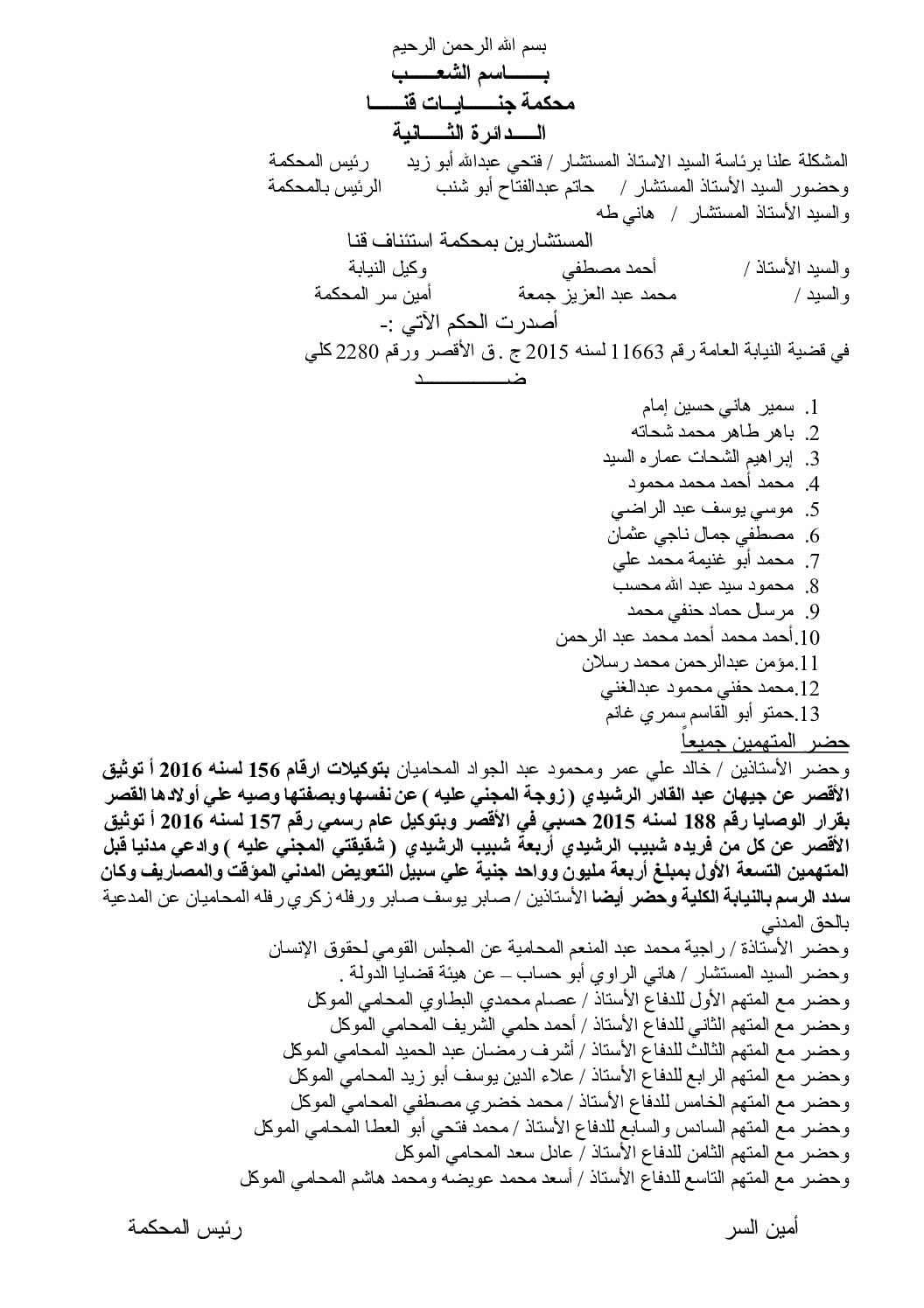About ECESR’s & Other’s Case Against MOI Use of Firearms: Case Details
Details of court decision: referral of the Case of banning the use of weapons in demonstrations to the constitutional courts
On 1 December 2011, the Egyptian Center for Economic and Social Rights (ECESR) and El Nadim Center for Rehabilitation of Victims of Violence filed a legal action (No.544 for the year 66Q) on behalf of Malek Mostafa and Fatima Abed against the President of the Supreme Council for the Armed Forces (SCAF) (later amended to the President of the Republic), the Prime Minister, and the Interior Minister.
The lawsuit demanded an urgent stop of implementation of Interior Minister decision No.156 in 1964, concerning the use of weapons and ammunition. It called for reconsidering the decision by the accused, who refused to issue a decree limiting actions against peaceful demonstrators and protesters to the use of water hoses from fire trucks and banning the use of fire arms, tear gas or any other form of weapons that could pose a risk to the lives of Egyptians, with all its implications and applying the draft decision without public announcement.
It demanded the annulment of the two decisions being challenged, with all its implications and paying all relevant legal charges by the administration.
The appeal elaborated on the Interior Minister decision No.156 of 1964, concerning the use of weapons and ammunition in implementation of Article 102 of the Police Law, authorizing the use of firearms to disperse crowds and demonstrations. The decision permitted officers and policemen to kill demonstrators and people in crowds, even if they did not partake in a behavior that indicates they will use violence.
The plaintiffs criticized the two decisions under appeal for their violation of the constitution and the laws, since the duty of the interior ministry is to ensure tranquility and peace for citizens, maintain public order and security, and protecting lives. It should not be killing citizens or injuring them. The use of firearms and violence against protesters and crowds is a violation of the right to life and bodily integrity and an assault on the right to free expression.
In conclusion of the appeal, the plaintiffs requested the court’s decision on the subject of the appeal. The plaintiff’s legal team was joined by ECESR, the Association for Freedom of Thought and Expression (AFTE), the Egyptian Initiative for Personal Rights (EIPR), and the Arab Network for Human Rights Information (ANHRI).
” The plaintiffs also presented three defense briefs on the unconstitutionality of the third paragraph of Article 102 of the Police Law No.109 for 1971 and the third paragraph of Article 1 of Interior Minister decision No.156 for 1964, concerning the use of firearms. “
On 28/2/2012, the court ruled on the admissibility of the case and referred it to the Supreme Constitutional Court.
Main Highlights of the Decision
On the Constitutional Protection of Human Rights:
“Whereby the Constitution promulgated on 25/12/2012 adopted the approach of former constitutional documents in providing constitutional protection to the rights of human freedom, adding some protective measures; and whereby the constitution committed the state to protecting souls and possessions, considering human dignity as a right to all humans, and obligated the protection of human dignity under all circumstances, including those restricting freedom due to a court decision or ruling; therefore [human beings] may not be terrorized or harmed, physically or morally, and their lives may not be put at risk. The constitution revealed that personal freedoms are a natural right, guaranteed the freedom of thought and expression, and protected the rights of all humans to express their opinions in various manners of expressions. It inscribed the right of citizens to hold peaceful public assemblies, marches, and demonstrations, without bearing arms, upon on a notification regulated by the law. The constitution prohibited all obstruction or diminishing of rights and freedoms inherent to the personhood of citizens and bars legislators, when regulating those rights and freedoms, from restricting them in any form that infringes on their nature or essence.”
On the Legal Nature of the Police Force and Limits of its Functions and on Cases of Use of Force and its Conditions:
“The constitution defined the nature of the police as being an organized civil body whose duty is to protect the people and apply the laws and regulations. It was assigned the duty of ensuring tranquility for citizens and protecting their dignity, rights, and liberties. In the Police Law, the legislator regulated the manner in which policemen may perform this duty, without the use force in principle, and grants recourse to force on the condition that it is the only possible manner to perform this duty. One of the forcible measures authorized by the legislator for the police force was the use of weapons in specific circumstances, which include the resistance or escape of particular convicts or defendants in criminal cases and specific misdemeanors and while guarding prisoners, under the conditions and circumstances inscribed in the Prisons Law. In Article 102 of the Police Law, the Legislator granted the use of arms to disperse crowds or demonstrations of more than five persons, in the case of a security risk, following a warning to the crowd to disperse, and on the condition that the order to use weapons comes from a superior. The Legislator set several controls to the use of weapons in the cases mentioned in Article 102 of the Police Law, one of them being that the use firearms is the only way to achieve the task. A warning must precede the use of firearms. The legislator charged the Interior Minister with identifying applicable procedures, the manner of the warning, and opening fire. The interior minister’s decision No.156 of 1964 set the regulations and procedures for opening fire, after the exhaustion of all other means, such as admonishment and use of clubs or teargas, depending on the situation. If this is not successful in dispersing the demonstration or crowds, then the use of small caliber shotguns (birdshot), then bullet firearms, and then automatic weapons.”
On Ensuring the Right to Demonstrate without Risking the Lives of Protesters:
“Whereby peaceful protestation is a human right and a branch of free expression enshrined in the Constitution, singled out in Article 50 in acknowledgment of the importance of demonstrations as a form of expression for citizens who want to express grievances related to the violation of their rights or freedoms…It must be provided with all means and license and may not be diminished under the pretext of regulation.”
On the Need for Administrative Regulation Authorities to Abide by the Constitution and the Law:
“…[To] ensure that these methods do not include a violation of the duty to protect the dignity, rights, and freedoms of citizens, if the Legislator intervenes and identifies the methods and manner of administrative regulation, such methods and manners must not be in contravention of Constitutional stipulations, since this will mean that the task of administration performed has fallen into the abyss of violating the Constitution.”
On the Limits of Application of Article 102 of the Police Law:
“…Peaceful demonstrations on public roads must be announced through a notification based on the provisions of Law No.14 of 1923, concerning the general stipulations for public meetings and demonstrations on public roads. The administration may not prohibit them in this case and the police must not obstruct the demonstrators through confrontation or prohibition and may not, in principle, use weapons or firearms against them. In this occurs, it will be a violation of the provisions of the Constitution and the Law.”
On the Right to Life and the Right to Bodily Integrity:
“Whereby the right to life is the most significant of all human rights and whereby all human rights and freedoms are carried by the right to life…no state may deprive human beings from their right to life, except as a retribution for a criminal offence, through a judicial decision, in the context of controls and safeguards established by the Constitution and the Law. Moreover, no state may violate the integrity of citizens, restrict their freedoms, or cause harm to them, unless within the limits of legitimacy concerning crime and punishment and inside the boundaries of constitutional and legal guarantees following a fair trial…[The] innate nature of criminal punishment is its effectiveness and it should not encompass unwarranted causing of pain or unnecessary cruelty. Furthermore, criminal punishment must not be disagreeable or effusive, which is the case when it is barbaric, involves torture, repressive, or related to acts that may not be criminalized.”
On the Limits of the Function of Public Administration:
“…[The] task and function of the Administration when initiating administrative control to maintain public order is always preventive…Means of administrative control may not be used as means of punishment or penalty and must not be comparable to criminal penalty in its severity, intensity, or effect…[Since] this would violate a package of constitutional guarantees and rights, which protect the rights and freedoms of citizens and forbids punishment except through a fair trial.”
On the Evidence of the Unconstitutionality of Article 102 of the Police Law:
“…Article 102 of the Police Law […] gives license to the Administration by the Legislator to use a means that could lead death in this case…It authorized the use of firearms against protesters to disperse demonstrations, as indicated in the aforementioned article, which is evidence to its violation of constitutional provisions, since it is an aggression on the right to life and bodily integrity […] and in violation of Article 31 of the Constitution, which compels the state to protect human lives.”
“…Granting the Administration the authority to fire at protesters to disperse a demonstration and the resulting death or injury of protesters is a mandate by the Legislator to the Administration, during its practice of administrative control – which are preventive measures in nature –, to perform an administrative duty, which exceeds, in its severity, the provisions of the criminal penalty which the judiciary is allowed to impose against protesters, in the case of breaching the provisions of Law No.14 of 1924, which organizes demonstrations. This means that the Administration is imposing a punishment on citizen protesters without a court ruling.”
“[The text of the Law Article] merely mentions the case of risk to public security, which is a vague motivation and could be solved through means, which cause less damage to citizens…Killing souls through a court order is the harshest of all punishments. It is only decreed against those who commit the most heinous of crimes, following recourse to right of defense, and is only applied only after the exhaustion of all recourse to appeal. The text did not indicate the need for an exceptional threat against public order in order to justify the use of firearms by the Administration.”
On the Inadequacy of Controls in Article 102 and the Related Executive Decision No.156 of 1964:
“The Legislator did not require the Administration to present the measures decided upon to the court or judicial body before firing on protesters to disperse a demonstration to demonstrate the exhaustion of applied means and procedures before opening fire and the justification for using firearms.”

